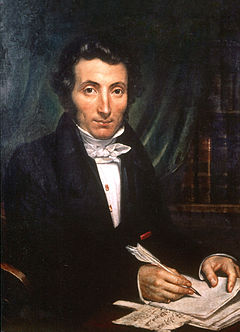René Caillié
René Caillié (born November 19, 1799 in Mauzé-sur-le-Mignon ( Deux-Sèvres ), France , † May 17, 1838 in La Gripperie-Saint-Symphorien near Rochefort ) was a French explorer of Africa .
Life
Caillié made his first trip to Africa at the age of 17. From the Senegalese port city of Saint-Louis , he marched south along the coast to Dakar and took a merchant ship to Martinique , where he stayed for half a year before returning to France. In 1818 he made a second trip to West Africa.
On the third voyage from 1824 onwards, he crossed Senegal in a northerly direction in order to penetrate into Arab territory. In the Mauritanian region Brakna he stayed for language preparation for a trip to the Sahara for eight months, among others, at a Marabout - tribal group ( Zwāyā , so scribes) on. He produced the first report by a European on the nomadic culture of the Bidhans in this area. He had to postpone the planned research trip because he could not find enough financial support.
After working for two years as an overseer in an indigo plantation in Sierra Leone , he had amassed enough money to start the trip. From the Rio Nunez in Guinea he marched east to the upper reaches of Senegal and on in 1827. On June 11, 1827, he reached the upper reaches of the Niger near Kouroussa . On April 20, 1828, he arrived alone and as a Muslim spending as the second European after Alexander Gordon Laing , Timbuktu . From there he crossed the Sahara and returned to Europe from Morocco .
Since Laing was killed in Africa, Caillié was the first to report on Timbuktu in Europe. Because of his descriptions of simple mud houses and dusty paths, which he found instead of the expected wealth, Caillié found himself exposed to severe criticism in Europe; especially from the British side it was assumed that he had never been to Timbuktu. For one thing, they did not want to believe that the once so rich Timbuktu had degenerated into an impoverished trading base. On the other hand, it was claimed that he had never been to Timbuktu, but obtained the records of the murdered Laing in a roundabout way, for example with the help of the French consul in Tripoli, and cannibalized them. Only the German Africa explorer Heinrich Barth , who stayed in the caravan town from September 1853 to April 1854, was able to fully rehabilitate Caillié.
Works
- Journal d'un voyage à Temboctou et à Jenné, dans l'Afrique centrale, précédé d'observations faites chez les Maures Braknas, les Nalous et autres peuples; pendant les années 1824, 1825, 1826, 1827, 1828: par René Caillié. Avec une carte itinéraire, et des remarques géographiques, by M. Jomard , membre de l'institut. Imprimé à Paris en mars 1830, par l'imprimerie royale. Tome 1 , Tome 2 , Tome 3 , (Tome 4), Tome 5 (annexes) , (Atlas)
German :
-
Journey to Timbuktu 1824–1828. Edited by H. Pleticha. Edition Erdmann, Tübingen 2006, ISBN 3-86503-037-8 .
- New edition: Marixverlag, Edition Erdmann, Wiesbaden 2012, ISBN 978-3-86539-834-5 .
literature
- Henri-Paul Eydoux: Exploring the Sahara. Freudenstadt 1949.
- Werner Legère: I was in Timbuktu. 1953.
- Alain Quella-Villéger: René Caillié, une vie pour Tombouctou. Poitiers 1999.
- Thomas Stangl : The only place. Graz 2004 and Munich 2006 (novel about Cailliés and Alexander Gordon Laing's travels to Timbuktu)
Web links
- Literature by and about René Caillié in the catalog of the German National Library
- Newspaper article about René Caillié in the 20th century press kit of the ZBW - Leibniz Information Center for Economics .
- Bibliography on the history of Timbuktu and the research trips there ( Memento from February 12, 2008 in the Internet Archive )
Individual evidence
- ^ E. Rackwitz: Stranger Paths - Far Shores: Risk and Adventure of Great Discoveries. 2nd Edition. Urania-Verlag, Leipzig / Jena / Berlin 1987, ISBN 3-332-00037-3 , p. 192.
- ↑ Pierre Viguier: Sur les traces de René Caillié. Le Mali de 1828 revisité. Versailles 2008, p. 22.
| personal data | |
|---|---|
| SURNAME | Caillié, René |
| BRIEF DESCRIPTION | French explorer of Africa |
| DATE OF BIRTH | November 19, 1799 |
| PLACE OF BIRTH | Mauzé-sur-le-Mignon , France |
| DATE OF DEATH | May 17, 1838 |
| Place of death | La Baderre near Paris |

